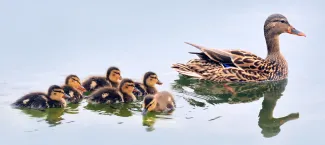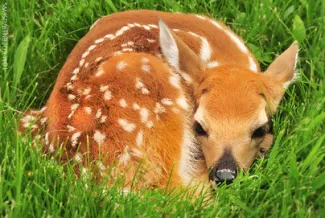
Biologists Say It's Best to Leave Young Wildlife Alone
This spring, more people are getting outdoors due to the COVID-19 situation, which means more people will come across newborn wildlife. Biologists with the Oklahoma Department of Wildlife Conservation are reminding everyone to resist the urge to “rescue” young wildlife, as that often does more harm than good.
Young wildlife belong in the wild, and even the most well-intentioned attempt to care for them often results in an unwanted outcome.
Finding a young animal by itself does not mean it’s been abandoned or needs to be rescued. The adult animals are often nearby and visit their young only occasionally to avoid detection from predators.
Young wildlife removed from the wild are denied important natural learning experiences that help them survive. So even if these animals are returned to the wild, their survival chances are reduced. Also, these animals may become tame and return to places where people live, only to be attacked by domestic animals or hit by vehicles.
And most of these “rescues” are also against the law.
Most people don’t realize that young wildlife may not legally be taken from the wild or kept as pets, because nearly all wild birds and mammals are protected by law. Most people quickly find they cannot properly care for young wildlife, and many of these animals soon die in the hands of people just trying to help.
In rare cases when a young animal is found with a dead parent or it has visible signs of injury, people can contact a licensed wildlife rehabilitator for advice and assistance. People might be asked to deliver an injured wild animal immediately to a licensed rehabilitator. The Wildlife Department licenses wildlife rehabilitators who are qualified to care for most injured or truly orphaned wildlife. A list of rehabilitators is online at wildlifedepartment.com/law/rehabilitator-list.
While people should not take young wildlife out of the wild, what can be done if someone runs across a newborn bird, bunnies or other animals? Here are some guidelines:
• Newborn birds or fledglings: While they might look helpless, they do not need assistance unless they have clear signs of injury, like a broken wing. If you find a hatchling or nestling (a young bird without feathers) outside the nest, you can try to return it to its nest or create an artificial nest. The parents will not reject the young bird if you touch it. If you find a fledgling (a young, fully feathered bird) outside the nest, leave it alone. While it is hopping around on the ground, the parents are usually nearby still taking care of it. If you find a fledgling near a road or exposed to danger, you can move it to a safer, sheltered location nearby.
• Bunnies, other young mammals: Generally, young mammals are visited by their mother only a few times a day to avoid attracting predators to the young. A nest of bunnies will only be visited by the adult female twice per day to nurse the young. The young are generally safe when left alone because their color patterns and lack of scent help them remain undetected. In most cases, it’s best to leave young animals alone.

• Fawns: Young deer are usually born in May and early June in Oklahoma. Even if you see a fawn alone for several days, you should still leave it alone. The animal may be motionless and seem vulnerable, but this is the normal behavior for a fawn, and the doe is probably feeding or bedding nearby. Fawns are safest when left alone because their colors and patterns help them remain undetected. Does visit their fawns to nurse very infrequently, a behavior that helps fawns avoid detection by predators. If sympathetic people repeatedly visit a fawn, it can prolong separation from the doe and delay needed feeding. If a fawn is visibly injured or found with its dead mother, it is best to call a wildlife rehabilitator listed at wildlifedepartment.com/law/rehabilitator-list. You may also call a local Game Warden listed online at wildlifedepartment.com/law/game-warden-directory, who can offer advice for the situation but will not move fawns.
The Outdoors Are Always Open! The Wildlife Department is working with the Oklahoma Health Department to craft messaging that promotes responsible outdoor recreation during the COVID-19 situation. The Department and health authorities agree that safeguarding mental health is important and spending time outdoors is a great way to do so, while following guidelines issued by federal and state authorities.